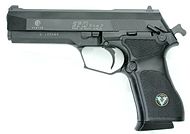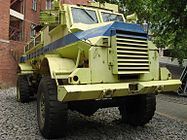
The G6, sometimes denoted as the G6 Rhino, is a South African self-propelled howitzer. It was developed as a turreted, self-propelled variant of the G5 howitzer series, mating the gun to a six-wheeled mine-protected armoured chassis. Design work on the G6 began in the late 1970s to replace the obsolescent Sexton being retired from service with the artillery regiments of the South African Army. Serial production commenced between 1988 and 1999.
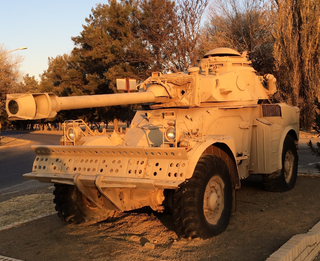
The Eland is an air-portable light armoured car based on the Panhard AML. Designed and built for long-range reconnaissance, it mounts either a 60mm (2.4 in) breech-loading mortar or a Denel 90mm (3.5 in) gun on a very compact chassis. Although lightly armoured, the vehicle's permanent 4X4 drive makes it faster over flat terrain than many tanks.

The Ratel is a South African infantry fighting vehicle. It was the first wheeled infantry fighting vehicle to enter service worldwide and was built on a modified MAN truck chassis. The Ratel was designed in response to a South African Army specification for a light armoured vehicle suited to the demands of rapid offensives, providing maximum firepower and strategic mobility to mechanised infantry units intended to operate across the vast distances of Southern Africa. Primarily envisaged in SADF doctrine as a vehicle that could deliver mechanised infantry and supporting fire to tanks in conventional warfare, it was also anticipated that the Ratel could form the centrepiece for semi-independent battlegroups where logistics or politics precluded the use of tanks. The Ratel was a simple, economical design which helped reduce the significant logistical commitment necessary to keep heavier combat vehicles operational in undeveloped regions. It was generally regarded as an influential concept which incorporated a number of novel features, such as a mine-protected hull, an extended operating range of 1,000 kilometres, and a 20 mm autocannon fitted with what was then a unique twin-linked ammunition feed, allowing turret gunners to rapidly swap between ammunition types during combat.

The Rooikat is a South African armoured reconnaissance vehicle equipped with a stabilised 76 mm (3.0 in) high velocity gun for organic anti-tank and fire support purposes. The Rooikat's main armament was built with the Oto Melara 76 naval gun as its basis, to which it is nearly identical in terms of technical performance and statistics. The Rooikat can also fire the same ammunition as the naval gun, albeit modified with new percussion primers in the shells.

The G5 is a South African towed howitzer of 155 mm calibre developed in South Africa by Denel Land Systems. The G5 design was based on the Canadian GC-45 155 mm gun which was highly modified to suit southern African conditions.

Denel Dynamics, formerly Kentron, is a division of Denel SOC Ltd, a South African armaments development and manufacturing company wholly owned by the South African Government. It underwent a name change from Kentron to Denel Aerospace Systems in early 2004 and later to Denel Dynamics. Denel Dynamics is located in Centurion, South Africa. Several sites are operating according to ISO 9000 and ISO 14000 certified.

The South African National Defence Force (SANDF) comprises the armed forces of South Africa. The Chief of the SANDF is appointed by the President of South Africa from one of the armed services. They are in turn accountable to the Minister of Defence and Military Veterans of the Defence Department.

The South African Defence Force (SADF) comprised the armed forces of South Africa from 1957 until 1994. Shortly before the state reconstituted itself as a republic in 1961, the former Union Defence Force was officially succeeded by the SADF, which was established by the Defence Act of 1957. The SADF, in turn, was superseded by the South African National Defence Force in 1994.

The South West Africa Territorial Force (SWATF) was an auxiliary arm of the South African Defence Force (SADF) and comprised the armed forces of South West Africa from 1977 to 1989. It emerged as a product of South Africa's political control of the territory which was granted to the former as a League of Nations mandate following World War I.
The Battle of Cuito Cuanavale was fought intermittently between 14 August 1987 and 23 March 1988, south and east of Cuito Cuanavale, Angola, by the People's Armed Forces for the Liberation of Angola (FAPLA) and Cuba against South Africa and the National Union for the Total Independence of Angola (UNITA) during the Angolan Civil War and South African Border War. The battle was the largest engagement of the Angolan conflict and the biggest conventional battle on the African continent since World War II. UNITA and its South African allies defeated a major FAPLA offensive towards Mavinga, preserving the former's control of southern Angola. They proceeded to launch a failed counteroffensive on FAPLA defensive positions around the Tumpo River east of Cuito Cuanavale.

The Vektor SS-77 is a general-purpose machine gun designed and manufactured by Denel Land Systems—formerly Lyttleton Engineering Works (LIW)—of South Africa.

The South African Border War, also known as the Namibian War of Independence, and sometimes denoted in South Africa as the Angolan Bush War, was a largely asymmetric conflict that occurred in Namibia, Zambia, and Angola from 26 August 1966 to 21 March 1990. It was fought between the South African Defence Force (SADF) and the People's Liberation Army of Namibia (PLAN), an armed wing of the South West African People's Organisation (SWAPO). The South African Border War was closely intertwined with the Angolan Civil War.

The Valkiri is a South African self-propelled multiple rocket launcher. It is a 127mm system with a wheeled launcher vehicle, and fire control equipment developed by Armscor. Contemporary models consist of a single launch module with five eight-cell rocket pods on a Unimog or SAMIL-100 carrier. Its mission is to engage in counter-battery strikes against hostile artillery and air defences as far as 36 km (22 mi) away. Other potential warheads include cluster and an anti-tank mine dispenser.
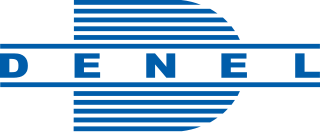
Denel SOC Ltd is a South African state-owned aerospace and military technology conglomerate established in 1992. It was created when the manufacturing subsidiaries of Armscor were split off in order for Armscor to become the procurement agency for the South African Defence Force (SADF), now known as the South African National Defence Force (SANDF), and the manufacturing divisions were grouped together under Denel as divisions. It is the largest of South Africa's state owned arms companies. The company had been experiencing major financial problems since 2015 and in 2021 it was announced in Parliament that Denel was on the brink of insolvency. The company stated that its woes were due to declining local defence budgets, weakened relationships with key customers and suppliers, the inability to retain or attract skilled personnel, ongoing salary disputes and a Fitch ratings downgrade.
The Atlas Aircraft Corporation was a South African aircraft manufacturer. It was a division of the South African government-owned defence conglomerate Armaments Corporation of South Africa.
The Atlas Carver was a proposed South African twin-engine, delta wing fourth-generation fighter aircraft. In development during the 1980s and early 1990s, the Carver was ultimately cancelled during 1991.
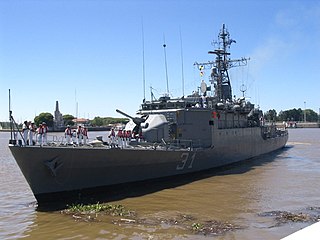
United Nations Security Council Resolution 418, adopted unanimously on 4 November 1977, imposed a mandatory arms embargo against South Africa. This resolution differed from the earlier Resolution 282, which was only voluntary. The embargo was subsequently tightened and extended by Resolution 591.

8 South African Infantry Battalion is a mechanized infantry unit of the South African Army. The battalion is equipped with Ratel Infantry Fighting Vehicles (IFV) used for fast transport and combat mobility across rough ground. Support weapons for mechanized infantry are also provided with motorized transport, or are built directly into these IFVs, in order to keep pace with the IFVs in combat. The battalion was raised at Upington in the Northern Cape on 01 October 1973 as part of the South African Infantry Corps, and since the change in structure, has been assigned to the Infantry Formation.
Zimbabwe Defence Industries (Pty) Ltd (ZDI) is a state-owned Zimbabwean arms manufacturing and procurement company headquartered in Harare, with a primary focus on sporting and military ammunition. In the past it has also manufactured mortar rounds, land mines, and light armoured fighting vehicles such as the Gazelle FRV. During the late 1990s, ZDI was involved in brokering major arms deals between China and other African governments such as the Republic of the Congo. The subsequent economic depression in Zimbabwe, as well as the collapse of the Zimbabwean dollar against major world currencies, have forced ZDI to limit its activity to exporting second-hand equipment from the Zimbabwe Defence Forces.
The South African defence industry is the most advanced in Africa and one of the most advanced and largest in the world with over 20 defence companies. The defence industry provides weapons and equipment to the South African National Defence Force (SANDF) and for export customers. The South African defence industry develops weapons and combat systems such as rifles, armored fighting vehicles, tanks, artillery, military aircraft, navy ships and missiles.


